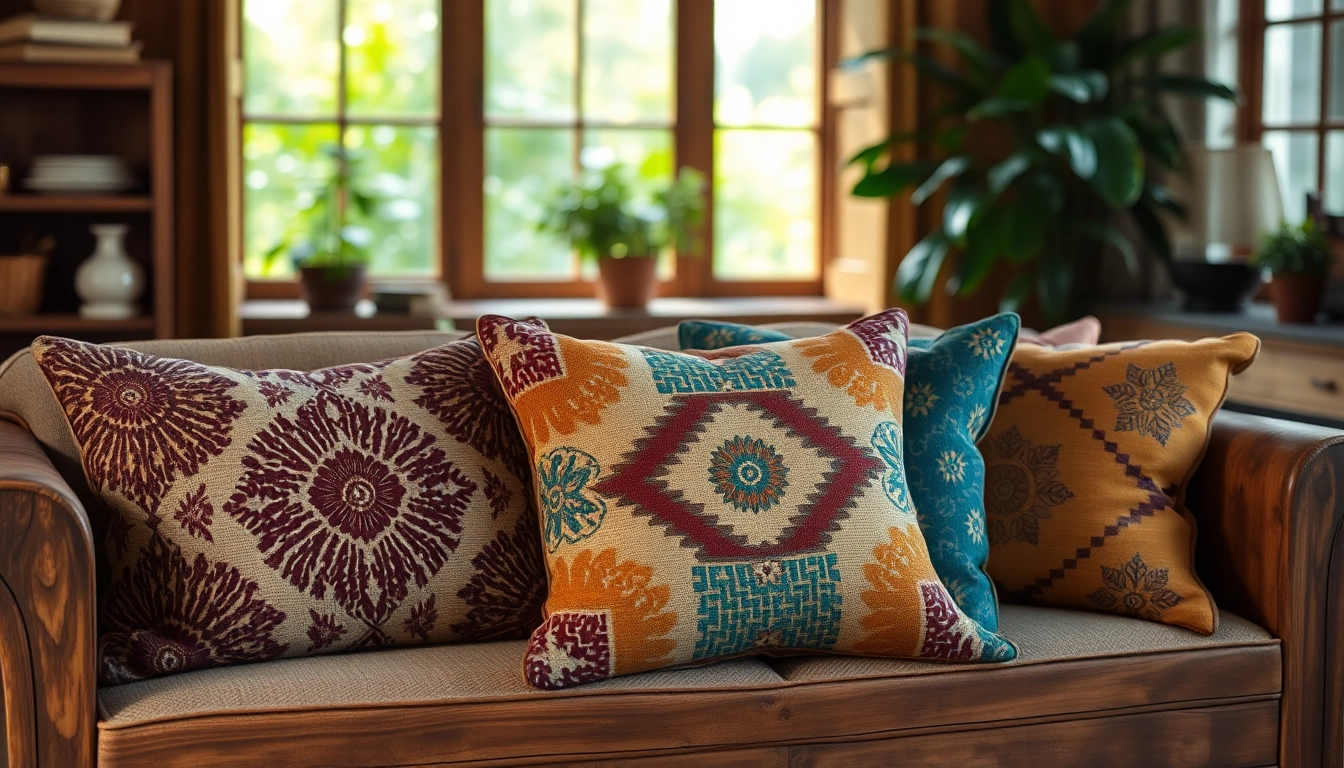Understanding Mali Mudcloth Cushion Covers
Origin and Cultural Significance
Mali Mudcloth, also known as bògòlanfini, boasts a rich history that transcends mere decorative appeal, capturing the essence of Malian culture. Originating from the Bamana people of Mali, this textile has been traditionally handwoven and dyed using fermented mud from local rivers. Each piece tells a story, often reflecting personal or communal experiences, making them a profound expression of identity and heritage.
The craft of mudcloth has been practiced for centuries and was historically utilized in various ceremonial functions such as weddings and rites of passage. With its roots deeply embedded in the Malian society, mudcloth represents resilience and cultural pride. Today, artisans continue to embrace this ancient technique, allowing the beauty of Mali’s traditions to endure while adapting to contemporary design trends. Incorporating Mali Mudcloth Cushion Covers in your home is not only a stylistic choice but also a celebration of this rich cultural narrative.
Materials Used in Crafting Cushion Covers
The primary component of Mali Mudcloth is cotton, which is locally sourced and hand-spun. Artisans skillfully craft the fabric through a labor-intensive process that involves weaving the cotton into long strips before dyeing it. The dyeing process is particularly notable; artisans use natural dyes derived from various plants and minerals, enhancing the organic feel and appearance of the fabric. Some colors may represent certain emotions or symbolize various aspects of life in Malian culture, adding layers of meaning to each cushion cover.
This meticulous approach not only showcases the artisans’ craftsmanship but also ensures that each cushion cover is unique. The process may include multiple dyeing sessions, allowing colors to enrich and deepen over time. The result is a durable, textural fabric that brings an authentic touch to home decor.
Design Variations and Patterns
Mali Mudcloth features a variety of geometric patterns and symbols, each carrying its own significance. Common motifs include stripes and checks, achieved through intricate stitching and painting techniques. These designs can range from simple geometric shapes to elaborate, symbolic compositions, reflecting various cultural narratives and beliefs.
The patterns are often rooted in the stories of the Bamana people, representing concepts such as fertility, wealth, and social status. When choosing mudcloth cushion covers, consider the significance of the designs you select; each symbol enriches the space with stories from the community, transforming your decor into a conversation starter.
Benefits of Incorporating Mali Mudcloth Cushion Covers into Your Home
Enhancing Aesthetic Appeal
Mali Mudcloth Cushion Covers are an effortless way to enhance the aesthetic appeal of any room. The earthy tones and rich textures can complement various interior styles, from bohemian to modern minimalist. Incorporating these cushion covers can add visual interest and warmth to your spaces, break the monotony of solid color palettes, and bring a touch of the exotic into homes.
The unique designs and history of mudcloth can evoke feelings of connection and comfort, creating an ambiance that speaks to inviting and harmonious living spaces. Whether placed on sofas, chairs, or beds, these cushion covers serve as vibrant focal points that invite the viewer to appreciate the artistry behind each piece.
Adding Comfort and Texture
Aside from their visual appeal, Mali Mudcloth Cushion Covers are also functional. The softness of the cotton fabric contributes to the overall comfort of your living space. They allow you to create a cozy and inviting environment, ideal for relaxing at home with family or entertaining guests.
Moreover, the unique texture of the fabric adds a tactile element to your decor, encouraging interaction and engagement. When layered with other textiles, such as knits and velvets, mudcloth covers offer a perfect contrast, providing depth and interest to your interior layout.
Supporting Artisans and Sustainable Practices
Choosing Mali Mudcloth Cushion Covers also aligns with ethical consumerism and sustainability. Each purchase supports artisans in Mali, allowing them to continue their traditional crafts and sustain their livelihoods. The promotion of these handcrafted items helps preserve cultural heritage while empowering local communities.
Sustainable practices are integral to the production of mudcloth, as the artisans utilize natural materials and dyes, thus minimizing environmental impact and fostering a sustainable design ethos. By incorporating these pieces into your home, you are contributing to a more equitable and sustainable global economy.
Choosing the Right Mali Mudcloth Cushion Covers for Your Space
Selecting Colors that Harmonize with Your Decor
When selecting Mali Mudcloth Cushion Covers, it’s essential to choose colors that harmonize with your existing decor. The earthy tones of mudcloth—browns, creams, and ochres—pair well with natural wood elements, greenery, and neutral palettes. For those looking to make a bold statement, choose covers with vibrant colors or contrasting patterns to create a striking focal point in the room.
Consider your overall design scheme; mixing different shades and patterns can add energy and eclecticism to your space, while a monochromatic approach can maintain a cohesive and sophisticated look. Always think about how each cushion cover fits within the larger context of your decor to ensure a balanced aesthetic.
Sizing and Placement Considerations
The size of your Mali Mudcloth Cushion Covers and their placement is crucial in affecting the overall look and feel of your space. Consider the dimensions of your furniture when selecting cushion sizes. Larger sofas may require larger cushions or a mix of sizes for a layered look, whereas smaller chairs may benefit from smaller, more compact covers.
Placement is equally important; arranging cushions asymmetrically can create a more casual and inviting atmosphere, while a symmetrical arrangement lends a more formal and polished appearance. Experiment with different combinations and placements to find a configuration that best suits your style and comfort needs.
Mixing and Matching with Other Decor Elements
One of the best aspects of Mali Mudcloth Cushion Covers is their versatility in pairing with various decor elements. These cushions can easily complement other textures such as linen, silk, and fleece, allowing for a harmonious blend of materials in your living space. Don’t shy away from mixing patterns—mudcloth works surprisingly well with stripes, florals, and other designs when approached thoughtfully.
When mixing and matching, consider varying the scale of patterns and textures to maintain visual interest without overwhelming the space. Additionally, adding elements like throws, rugs, or art that echo the colors found in the cushion covers can seamlessly tie together your decor theme.
Caring for Your Mali Mudcloth Cushion Covers
Cleaning Techniques to Ensure Longevity
To ensure the longevity of your Mali Mudcloth Cushion Covers, proper cleaning is essential. These covers, being hand-dyed and crafted from natural materials, should be treated with care. When washing, it is recommended to hand wash using cold water and mild detergent to avoid fading and damage to the fabric. Avoid bleach and harsh chemicals, which can compromise the integrity of the dye.
For stubborn stains, spot-cleaning with a damp cloth may suffice, but always test cleaning methods on a less visible area first. Air drying is preferable to machine drying, as it preserves the texture and color quality of the fabric.
Storing Cushion Covers Properly
Proper storage of your Mali Mudcloth Cushion Covers can significantly extend their lifespan. If you need to store them, ensure they are clean and completely dry to prevent mildew or odor. Fold them neatly and store them in a breathable fabric bag or a box lined with acid-free tissue paper to protect against dust and potential damage from environmental factors.
Keep them in a cool, dry place away from direct sunlight, as prolonged exposure to UV light can deteriorate the color and fabric quality over time. Regularly check stored items to ensure they remain in good condition and free from storage pests.
Repairing Minor Damages
Despite your best care efforts, wear and tear may occur. Minor damages, such as small tears or loose seams, can often be mended easily. Using a needle and thread similar in color to the fabric, you can stitch up any small frays. For larger tears, consider seeking professional repair to avoid compromising the aesthetic and integrity of the cushion cover.
Learning basic sewing skills can empower you to effectively restore these beautiful pieces of textile art, and regular maintenance can ensure that your investment continues to bring joy and beauty to your home for years to come.
Where to Buy Authentic Mali Mudcloth Cushion Covers
Recommended Online Retailers
When shopping for genuine Mali Mudcloth Cushion Covers, it’s important to purchase from reputable retailers to ensure authenticity and quality. Online platforms such as Etsy and specialized home decor shops often feature a selection of handmade options, allowing you to find unique pieces directly from artisans. Additionally, retailers that focus on ethical sourcing can provide assurance that your purchase supports traditional craftsmanship.
Choosing Ethical Sources
As the demand for authentic African textiles grows, it’s crucial to choose sources that prioritize ethical practices. Look for retailers that clearly communicate their relationships with artisans and provide transparency about their sourcing methods. Ensuring that artisans are fairly compensated and work in safe conditions is essential in actively supporting sustainable practices.
Buying directly from artisans when possible, whether through craft fairs or local markets, can also foster personal connections and understanding behind the craftspeople’s stories, enriching your experience with the product even further.
What to Look For in Quality Products
When selecting Mali Mudcloth Cushion Covers, there are several quality indicators to keep in mind. First, examine the fabric’s texture; authentic mudcloth should feel robust yet soft, with visible variations that reflect its handcrafted nature. Additionally, the patterns should be clearly defined, with consistent execution across the piece.
Check for stitching quality; well-made cushion covers should have strong seams and be fully lined for added durability. The colors should be vibrant, with little to no fading to indicate the use of authentic dyes. Lastly, ask questions regarding the source to ensure you are receiving an authentic product that supports the artisans’ craft.



